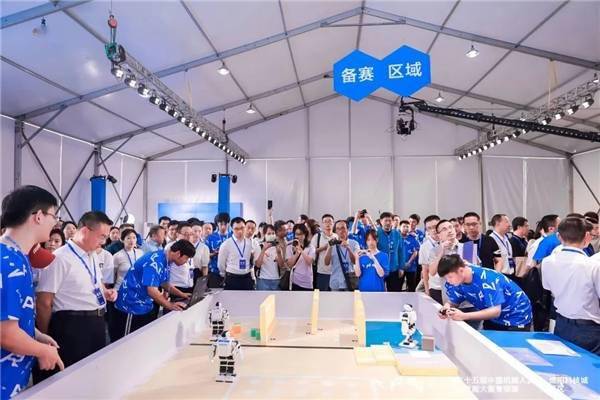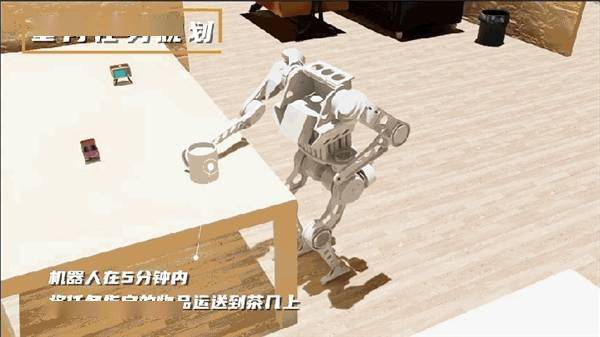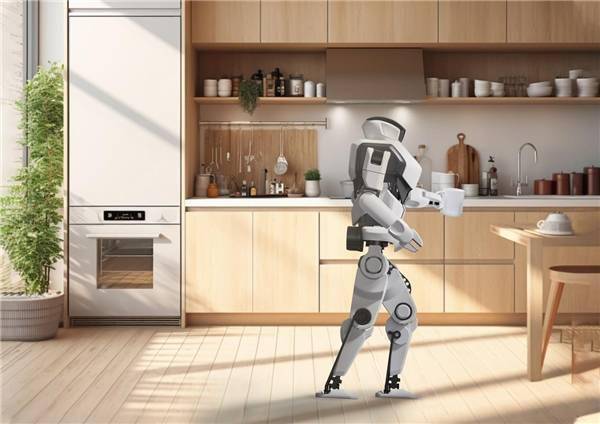 Technology peripherals
Technology peripherals
 AI
AI
 The first domestic humanoid robot competition prospect report released
The first domestic humanoid robot competition prospect report released
The first domestic humanoid robot competition prospect report released
The 26th China Robot and Artificial Intelligence Competition Humanoid Robot Innovation Challenge was officially released in Suzhou on December 28.
This competition is hosted by the China Robot and Artificial Intelligence Competition Organizing Committee, Leju (Suzhou) Robot Technology Co., Ltd., Beijing General Artificial Intelligence Research Institute, Suzhou University Robotics and Microsystem Center, Shenzhen Kaihong Digital Industry Development Co., Ltd. It is hosted by the company and co-organized by more than ten companies including Haier Robotics Technology (Qingdao) Co., Ltd. and China Mobile (Hangzhou) Information Technology Co., Ltd. This event is divided into an online simulation trial and an offline main competition. The online simulation trial will be held from January to April 2024, and the offline main competition will be held in Taihu New Town, Wujiang District, Suzhou City in the summer of 2024.
With the core of "promoting research through competition, promoting production through research, and gathering intelligence to tackle key problems", the competition aims to promote the ecological integration of upstream and downstream, focusing on typical cases of families and special scenes, to accelerate the mass production of humanoid robots and the implementation of industrial scale.
The first humanoid robot competition "close to real scenes" held in China has attracted widespread attention. This competition aims to test the performance and adaptability of humanoid robots in various situations by simulating real scenarios. Participants need to use humanoid robots designed and built by themselves to complete a series of tasks, including walking, grabbing objects, interacting with humans, etc. This competition not only tests the technical level of the robot, but also examines its autonomy and intelligence in the process of interacting with humans. Through such events, people can have a more intuitive understanding of the development status and possible future application fields of humanoid robots.
The China Robot and Artificial Intelligence Competition has been successfully held for 25 times since its inception in 1999. It is an event with a long history. The impact of this event is very wide, and the cumulative number of participants has exceeded 270,000. At the same time, the scale of this event is also very large, attracting more than 600 universities across the country to participate, including top domestic universities such as Tsinghua University, Fudan University, and Harbin Institute of Technology. It can be said that this competition has gradually developed into one of the most influential and comprehensive technical competitions in robotics in China.

Picture|Previous competitions
This Humanoid Robot Innovation Challenge is an event that closely follows the trend of the times. It is comparable to DARPA’s top international events and is the first large-scale humanoid robot competition held in China.
This competition has received support from Beijing Institute of General Artificial Intelligence, Suzhou University Robotics and Microsystems Center, Zhijiang Laboratory, China Academy of Information and Communications Technology Taier Terminal Laboratory, Harbin Institute of Technology Department of Computing, Tsinghua University School of Integrated Circuits, Shandong It is strongly supported by top domestic universities and institutions such as the University's School of Computer Science and Technology. At the same time, the competition also specially invited academicians and outstanding young people from relevant fields to form an expert group to provide strong support to the contestants. The support of these top universities and institutions, as well as the participation of the expert team, will create a high-standard, high-level, and highly professional event exchange platform for the contestants.

Picture|Virtual simulation competition
The event is close to the real scene, and the challenge event setting has created many "firsts": it is the first time to move from a simulation scene to a real family and special service scene, it is the first time to realize a fully autonomous intelligent operation competition, and it is the first time to introduce generative big data into the competition. Model task planning and assessment.
The difficulty level of this competition has also been fully upgraded. Participating teams will face the challenges of eight scenario tasks such as cargo picking and placing, terrain adaptation, and valve switching. They will collectively tackle the technical problems that humanoid robots will face in future service and production scenarios, and promote the technology research and development and practical application of humanoid robots.
Giant companies are leading and accelerating the development of "humanoid robot" scenario applications. The application prospects of this emerging field are very broad, and giants have invested resources in R&D and innovation. These humanoid robots have a wide range of applications, including but not limited to assisting the elderly and the disabled, industrial production, medical care and other fields. The participation of giant companies will further promote the development and application of humanoid robot technology and bring more convenience and innovation to society.
This competition is led by industry leading companies such as Haier Robotics Technology (Qingdao) Co., Ltd. and China Mobile (Hangzhou) Information Technology Co., Ltd., and is co-organized by more than ten upstream and downstream related companies. In this competition, Zhijiang Laboratory, CAICT Tell Terminal Laboratory, Leju (Suzhou) Robot Technology Co., Ltd., Shenzhen Kaihong Digital Industry Development Co., Ltd., Jiangsu Huibo Robot Technology Co., Ltd., Suzhou Junduo Robotics Co., Ltd. and some relevant university research institutes and other units will cooperate to achieve a series of key technological and product innovation breakthroughs. These key technologies and product innovations include humanoid robot components, such as servo motors, reducers, controllers, sensors, etc., as well as software aspects such as environmental perception, human-computer interaction, machine learning, and system control.

The schematic diagram shows the application of KUAVO in real scenarios. It shows the functions and uses of KUAVO drones in different environments. In the picture, we can see that KUAVO drone is used for crop spraying in farmland. It can accurately control the amount of pesticide spraying and improve the growth effect of crops. In addition, in cities, KUAVO drones can be used for patrols and surveillance, providing efficient security measures. The picture also shows the application of KUAVO drones in rescue operations. It can carry medical supplies, quickly reach disaster areas, and provide first aid to injured people. Overall, this schematic shows us the versatility and practicality of the KUAVO drone in a variety of real-world scenarios.
As leading companies, Haier and China Mobile will use their resource advantages of their huge user base and wide range of application scenarios to promote the creation of typical application cases of robots in smart homes, smart manufacturing, special services and other scenarios, and accelerate The innovative application process of "humanoid robot" in multiple scenarios.
Suzhou Robot Industry Association and China Robot Network are units that particularly support the "Market Promotion and Influence Improvement of Humanoid Robots". By linking resources upstream and downstream of the industrial chain, they achieve collaborative innovation of resources and provide strong support for market promotion and influence in this field.
Gather intelligence to tackle key problems and promote “mass production” and “scale” applications
Humanoid robots are considered an important symbol to measure a country's innovation level and industrial capabilities. It integrates the latest achievements of high-precision technology and is known as a treasure in the field of robotics.
Recently, the Ministry of Industry and Information Technology issued the "Guiding Opinions on the Innovation and Development of Humanoid Robots." This guidance points out that humanoid robots are expected to become disruptive products after computers, smartphones, and new energy vehicles, and clearly sets the goal of achieving mass production in 2025.

The schematic diagram shows the application of KUAVO in real scenarios. It shows the functions and uses of KUAVO drones in different environments. In the picture, we can see that KUAVO drone is used for crop spraying in farmland. It can accurately control the amount of pesticide spraying and improve the growth effect of crops. In addition, in cities, KUAVO drones can be used for patrols and surveillance, providing efficient security measures. The picture also shows the application of KUAVO drones in rescue operations. It can carry medical supplies, quickly reach disaster areas, and provide first aid to injured people. Overall, this schematic shows us the versatility and practicality of the KUAVO drone in a variety of real-world scenarios.
Through the holding of humanoid robot competitions, the vitality of technological innovation can be stimulated and the process of industrialization development can be accelerated. Integrate actual production and life into humanoid robot competition scenarios, give full play to the advantages of each research field, and pool wisdom to solve application problems in future general scenarios, help humanoid robots move from virtual to real scenes, from technology to industry, and accelerate the mass production of humanoid robots. production and large-scale application.
The above is the detailed content of The first domestic humanoid robot competition prospect report released. For more information, please follow other related articles on the PHP Chinese website!

Hot AI Tools

Undresser.AI Undress
AI-powered app for creating realistic nude photos

AI Clothes Remover
Online AI tool for removing clothes from photos.

Undress AI Tool
Undress images for free

Clothoff.io
AI clothes remover

AI Hentai Generator
Generate AI Hentai for free.

Hot Article

Hot Tools

Notepad++7.3.1
Easy-to-use and free code editor

SublimeText3 Chinese version
Chinese version, very easy to use

Zend Studio 13.0.1
Powerful PHP integrated development environment

Dreamweaver CS6
Visual web development tools

SublimeText3 Mac version
God-level code editing software (SublimeText3)

Hot Topics
 1385
1385
 52
52
 Using Apple Vision Pro to control robots from a distance, NVIDIA: It's not difficult to 'integrate man and machine”
Aug 01, 2024 am 03:16 AM
Using Apple Vision Pro to control robots from a distance, NVIDIA: It's not difficult to 'integrate man and machine”
Aug 01, 2024 am 03:16 AM
Huang Renxun said: "The next wave of AI is robots, and one of the most exciting developments is humanoid robots." Today, ProjectGR00T has taken another important step. Yesterday, NVIDIA founder Huang Renxun talked about its universal basic model of humanoid robot "ProjectGR00T" in his SIGGRAPH2024 Keynote speech. The model receives a series of updates in terms of functionality. Zhu Yuke, an assistant professor at the University of Texas at Austin and a senior research scientist at NVIDIA, tweeted, demonstrating in the video how NVIDIA integrates the RoboCasa and MimicGen systems, the large-scale simulation training framework for general household robots, into the NVIDIA Omniverse platform and Isaac machine
 The full-size universal humanoid robot Qinglong debuts at WAIC, accelerating the entry into the era of embodied intelligence
Jul 11, 2024 pm 02:03 PM
The full-size universal humanoid robot Qinglong debuts at WAIC, accelerating the entry into the era of embodied intelligence
Jul 11, 2024 pm 02:03 PM
On the afternoon of July 4, under the guidance of the World Artificial Intelligence Conference Organizing Committee Office, hosted by the World Artificial Intelligence Conference Organizing Committee Office, and hosted by the National and Local Humanoid Robot Innovation Center and the China Institute of Electronics, this site, "Robotics Technology and Applications" The 2024 WAIC World Artificial Intelligence Conference Humanoid Robot and Embodied Intelligence Development Forum co-organized by the magazine will be held at the Shanghai World Expo Exhibition and Convention Center on the afternoon of July 4. This forum invited 12 domestic and foreign scholars, business representatives and developer representatives in the field of humanoid robots and embodied intelligence to give keynote reports, technology sharing and roundtable discussions, and released innovative results of humanoid robots. The forum attracted more than 200 professional audiences in the field of humanoid robots and embodied intelligence, and they were watched online through multiple live broadcast platforms.
 Microsoft, OpenAI plan to invest $100 million in humanoid robots! Netizens are calling Musk
Feb 01, 2024 am 11:18 AM
Microsoft, OpenAI plan to invest $100 million in humanoid robots! Netizens are calling Musk
Feb 01, 2024 am 11:18 AM
Microsoft and OpenAI were revealed to be investing large sums of money into a humanoid robot startup at the beginning of the year. Among them, Microsoft plans to invest US$95 million, and OpenAI will invest US$5 million. According to Bloomberg, the company is expected to raise a total of US$500 million in this round, and its pre-money valuation may reach US$1.9 billion. What attracts them? Let’s take a look at this company’s robotics achievements first. This robot is all silver and black, and its appearance resembles the image of a robot in a Hollywood science fiction blockbuster: Now, he is putting a coffee capsule into the coffee machine: If it is not placed correctly, it will adjust itself without any human remote control: However, After a while, a cup of coffee can be taken away and enjoyed: Do you have any family members who have recognized it? Yes, this robot was created some time ago.
 Kepler Forerunner series of universal humanoid robots officially launched
Nov 20, 2023 pm 05:38 PM
Kepler Forerunner series of universal humanoid robots officially launched
Nov 20, 2023 pm 05:38 PM
(Global TMT November 20, 2023) On November 17, Kepler’s Forerunner series of general-purpose humanoid robots were officially unveiled, including three models: K1, S1 and D1. Kepler focuses on the R&D, production and application ecosystem construction of universal humanoid robots. The self-developed Kepler humanoid robot aims to be infinitely close to the human form. It has a highly bionic humanoid walking structure and motion control. It is expected to achieve commercial mass production in the future. The Kepler humanoid robot launched this time, priced between US$20,000 and US$30,000, has a height of 178cm and a weight of 85kg. It has 12 degrees of freedom in its intelligent and dexterous hands and up to 40 degrees of freedom in joints throughout its body. It is capable of walking on complex terrain. , intelligent obstacle avoidance, flexible hand control, powerful
 Beijing Humanoid Robot Innovation Center was established to create the world's first software and hardware 'mother platform'
Nov 05, 2023 am 08:13 AM
Beijing Humanoid Robot Innovation Center was established to create the world's first software and hardware 'mother platform'
Nov 05, 2023 am 08:13 AM
According to reports on November 4, the first provincial-level humanoid robot innovation center in China, Beijing Humanoid Robot Innovation Center Co., Ltd., was officially registered at the Robot Innovation Industrial Park of Beijing Economic Development Zone on Thursday. This marks The first provincial-level humanoid robot innovation center in China was established. ▲ Picture source public account "Beijing Yizhuang" According to reports, the company is jointly established by companies such as complete robots, core components, and large models. It will create the world's first universal humanoid robot "hardware mother platform" and the first large model + open source The "software mother platform" of the operation control system has been developed, and five key tasks including universal humanoid robot body prototype, universal large model of humanoid robot, operation control system, tool chain, open source OS and developer community have been carried out. Currently, Beijing has national-level robots
 Tesla humanoid robots take to the streets collectively! Musk: Cheaper than cars, there will be 10 billion units
May 31, 2023 pm 08:01 PM
Tesla humanoid robots take to the streets collectively! Musk: Cheaper than cars, there will be 10 billion units
May 31, 2023 pm 08:01 PM
Tesla Optimus has evolved, and the price is "lower than the car." Source | Qubit ID: QbitAI Author | Reprinted by Jin Lei Xifeng with permission Musk’s humanoid robot, Tesla Optimus, has evolved, and the price is “lower than a car.” Now, groups of Optimus have learned to move forward slowly like humans: in the video, they also passed by the Cybertruck production room, full of cyberpunk flavor. Moreover, Optimus are not simply walking, but discover and remember the surrounding environment while walking: Next, there is a more detailed demonstration of their abilities. For example, Tesla demonstrated the ability of Optimus motor torque control, which can control the force without breaking eggs: manual work is also passable.
![[Most Complete] Comprehensive comparison of leading companies in China's humanoid robot industry in 2023 (with business layout summary, etc.)](https://img.php.cn/upload/article/000/887/227/169505190951541.png?x-oss-process=image/resize,m_fill,h_207,w_330) [Most Complete] Comprehensive comparison of leading companies in China's humanoid robot industry in 2023 (with business layout summary, etc.)
Sep 18, 2023 pm 11:45 PM
[Most Complete] Comprehensive comparison of leading companies in China's humanoid robot industry in 2023 (with business layout summary, etc.)
Sep 18, 2023 pm 11:45 PM
——Original title: [The most complete] Comprehensive comparison of leading companies in China's humanoid robot industry in 2023 (with business layout summary, performance comparison, business planning, etc.) The main leading companies in the humanoid robot industry: Xiaomi Group-W (01810.HK); Zhiyuan Robot; Youbixuan; Dacha; Fourier; Zhumi Technology, etc. The core data of this article: regional competition among Chinese humanoid robot companies; comparison of business layout of Chinese humanoid robot companies; comparison of business plans of Chinese humanoid robot companies; summary of leading companies in the humanoid robot industry at present , the number of leading companies in the manufacturing of humanoid robots in China is relatively small, but there are many representative companies in the entire humanoid robot industry. Among them, the upstream core parts companies include reducer manufacturers Green Harmonic, Double Ring Transmission, Zhongli De
 Tesla's Optimus humanoid robot works in the factory, is skilled in disassembling batteries, self-correcting, and can go even further
May 06, 2024 pm 02:52 PM
Tesla's Optimus humanoid robot works in the factory, is skilled in disassembling batteries, self-correcting, and can go even further
May 06, 2024 pm 02:52 PM
Tesla humanoid robot has unlocked new skills! Yesterday, Tesla Optimus officially released a new demo video, showing the latest progress of the second-generation Optimus humanoid robot. This time, Optimus started working in the factory. He learned to assemble batteries at the Tesla battery factory and walked faster, farther and more steadily than before. Let’s take a first look at Optimus’ latest skills and training details. Optimus’ end-to-end neural network is now trained to accurately assemble battery cells at Tesla factories. Runs in real time on the robot's FSD computer, relying solely on 2D cameras, hand touch and force sensors. Optimus uses its legs to maintain balance while the network drives its entire upper body.



